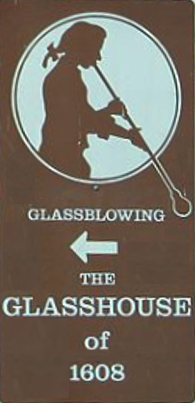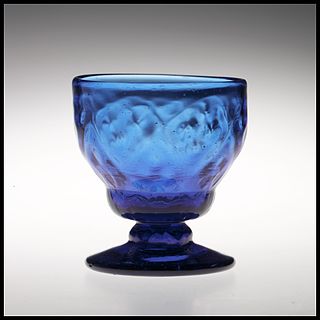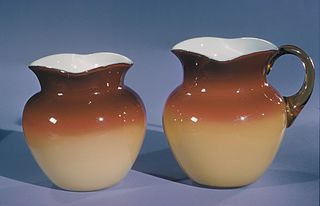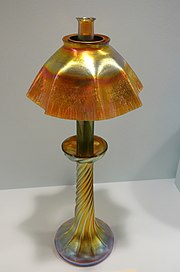
Favrile glass is a type of iridescent art glass developed by Louis Comfort Tiffany. He patented this process in 1894 and first produced the glass for manufacture in 1896 in Queens, New York. It differs from most iridescent glasses because the color is ingrained in the glass itself, as well as having distinctive coloring. Tiffany won a grand prize at the 1900 Paris Exposition for his Favrile glass.
Bakewell Glass is nineteenth-century glassware from Pittsburgh, Pennsylvania, produced by a company founded by Benjamin Bakewell. Bakewell's company can be found under the names ThePittsburgh Glass Manufactory, Bakewell & Page and, Bakewell, Pears & Co. Bakewell glass built a reputation of being both luxurious and utilitarian during the 80 years it was in business.
The Fostoria Glass Company was a manufacturer of pressed, blown and hand-molded glassware and tableware. It began operations in Fostoria, Ohio, on December 15, 1887, on land donated by the townspeople. The new company was formed by men from West Virginia who were experienced in the glassmaking business. They started their company in northwest Ohio to take advantage of newly discovered natural gas that was an ideal fuel for glassmaking. Numerous other businesses were also started in the area, and collectively they depleted the natural gas supply. Fuel shortages caused the company to move to Moundsville, West Virginia, in 1891.
Libbey, Inc., is a glass production company headquartered in Toledo, Ohio. It was originally founded in 1818 in Cambridge, Massachusetts, as the New England Glass Company, before relocating to Ohio in 1888 and renaming to Libbey Glass Co. After it was purchased in 1935, it operated as part of the Libbey-Owens-Ford company and as a division of the Owens-Illinois glass company until 1993, when it was separated back into an independent company.

Deming Jarves (1790–1869) was a 19th-century American glass manufacturer in Massachusetts. He has been called the "father of the American glass industry". Jarves joined the glass industry in 1809 when he, with a group of investors, gained control of the window glass company Boston Crown Glass. During the War of 1812, American glass manufacturers lost access to high–quality sand and red lead, which was an essential ingredient for high–quality glass. After the war, British manufacturers began dumping low–priced glass in the United States. This caused many American glass manufacturers, including Boston Crown Glass, to go out of business. In 1818 Jarves and an investor group founded the New England Glass Company, where Jarves researched ways to produce red lead using domestic sources. By 1819 he was producing red lead, which enabled the production of better quality glass.
Novelty Glass Company of Fostoria was one of over 70 glass manufacturing companies that operated in northwest Ohio during the region's brief Gas Boom in the late 19th century. The company made bar goods, stemware, and novelties. Organization of the firm began late in 1890, with banker Rawson Crocker as president and veteran glass man Henry Crimmel as plant manager. Production started in February 1891. The plant was built on the site of the former Buttler Art Glass Company, which had been destroyed by fire in 1889.

Hartford City Glass Company was among the top three window glass manufacturers in the United States between 1890 and 1899, and continued to be one of the nation's largest after its acquisition. It was also the country's largest manufacturer of chipped glass, with capacity double that of its nearest competitor. The company's works was the first of eight glass plants that existed in Hartford City, Indiana during the Indiana Gas Boom. It became the city's largest manufacturer and employer, peaking with 600 employees.
Seneca Glass Company was a glass manufacturer that began in Fostoria, Ohio, in 1891. At one time it was the largest manufacturer of blown tumblers in the United States. The company was also known for its high-quality lead (crystal) stemware, which was hand-made for nearly a century. Customers included Eleanor Roosevelt and Lyndon B. Johnson, and retailers such as Marshall Field and Company, Neiman Marcus, and Tiffany's.

Early glassmaking in the United States began in Colonial America in 1608 at the Colony of Virginia near Jamestown, believed to be the first industrial facility in what would later become the United States. For centuries, glassmaking procedures, techniques, and recipes were kept secret, with countries actively preventing glassmaking knowledge from spreading beyond their borders. German workers with glassmaking knowledge, described as Dutchmen, along with Polish glass workers, were brought to Colonial America to begin operations. Although glass was made at Jamestown, production was soon suspended because of strife in the colony. A second attempt at Jamestown also failed.
J. H. Hobbs, Brockunier and Company was one of the largest and best-known manufacturers of glass in the United States during the 19th century. Its products were distributed worldwide. The company is responsible for one of the greatest innovations in American glassmaking—an improved formula for lime glass that enabled American glass manufacturers to produce high-quality glass at a lower cost. The firm also developed talented glassmakers that started glass factories in Ohio and Indiana.

The New Geneva Glass Works was an early American glass factory established in western Pennsylvania, active from 1797 until 1847.
Indiana Glass Company was an American company that manufactured pressed, blown and hand-molded glassware and tableware for almost 100 years. Predecessors to the company began operations in Dunkirk, Indiana, in 1896 and 1904, when East Central Indiana experienced the Indiana gas boom. The company started in 1907, when a group of investors led by Frank W. Merry formed a company to buy the Dunkirk glass plant that belonged to the bankrupt National Glass Company. National Glass was a trust for glass tableware that originally owned 19 glass factories including the plant in Dunkirk. National Glass went bankrupt in 1907, and its assets were sold in late 1908.
The Nickel Plate Glass Company was a manufacturer of tableware, lamps, and bar goods. It began operations in Fostoria, Ohio, on August 8, 1888, on land donated by the townspeople. The new company was formed by men from West Virginia who were experienced in the glassmaking business, and their company was incorporated in that state in February of the same year. They were lured to northwest Ohio to take advantage of newly discovered natural gas that was an ideal low-cost fuel for glassmaking. The company name came from the New York, Chicago and St. Louis Railroad, commonly known as the "Nickel Plate Road", which had tracks adjacent to the new glass plant.
The Fostoria Shade and Lamp Company was the largest manufacturer of glass lamps in the United States during the early 1890s. It began operations in Fostoria, Ohio, on May 17, 1890. The plant was run by Nicholas Kopp Jr., a former chemist at Hobbs, Brockunier and Company in West Virginia. Kopp achieved fame for his many glass designs and formulas for various colors of glass, and he is the discoverer of the American formula for selenium-based ruby glass. The company's products were very popular, and it was able to make significant profits early in its existence. In addition to lamps and shades for home lighting, the company also made novelties such as salt shakers.
Mambourg Glass Company was a window glass manufacturer that began production on October 26, 1887. The company was the first of thirteen glass manufacturers located in Fostoria, Ohio, in the United States, during northwest Ohio's gas boom. The plant was managed by Leopold Mambourg, a Belgian immigrant and experienced glassmaker. Much of the company's work force was also from Belgium. Former Ohio governor Charles Foster was president of the company and a major financial backer. He was also a major investor in other businesses and two additional Fostoria window glass companies: the Calcine Glass Company and the Crocker Glass Company. Mambourg was the chief operating officer for all three of Foster's window glass companies.
The Bellaire Goblet Company was the largest manufacturer of goblets in the United States during the 1880s. Its original glass plant was located in Bellaire, Ohio, which earned the nickname "Glass City" because of its many glass factories. Bellaire Goblet Company was part of Ohio's "Glass City" on the east side of the state, and later moved to the other side of the state to participate in Northwest Ohio's "Gas Boom". It also became part of a large glass trust.

18th century glassmaking in the United States began before the country existed. During the previous century, several attempts were made to produce glass, but none were long-lived. By 1700, it is thought that little or no glass was being produced in the British colonies that would eventually become the United States. The first American glass factory operated with long–term success was started by Caspar Wistar in 1745—although two glass works in New Amsterdam that operated in the previous century deserve honorable mention. Wistar's glass works was located in the English colony known as the Province of New Jersey. In the southeastern portion of the Province of Pennsylvania, Henry Stiegel was the first American producer of high–quality glassware known as crystal. Stiegel's first glass works began in 1763, and his better quality glassmaking began in 1769. In the United States, the first use of coal as a fuel for glassmaking furnaces is believed to have started in 1794 at a short-lived factory on the Schuylkill River near Philadelphia. In 1797 Pittsburgh's O'Hara and Craig glass works was also powered by coal, and it contributed to the eventual establishment of Pittsburgh as a leading glassmaking center in the 19th century.

19th century glass categories in the United States include types of glass and decoration methods for glass. A simplified category version appropriate at the beginning of the century is glassware, bottles, and windows. As the century progressed, glass production became more complex and made necessary more categories and subcategories. An 1884 United States government report used glassware, bottles, windows, and plate glass as major categories—although plate glass accounted for only four percent of the value of all glass made.

19th century glassmaking in the United States started slowly with less than a dozen glass factories operating. Much of the nation's better quality glass was imported, and English glassmakers had a monopoly on major ingredients for high–quality glass such as good–quality sand and red lead. A tariff and the War of 1812 added to the difficulties of making crystal glass in America. After the war, English glassmakers began dumping low priced glassware in the United States, which caused some glass works to go out of business. A protective tariff and the ingenuity of Boston businessman Deming Jarves helped revive the domestic glass industry.
Bakewell, Pears and Company was Pittsburgh's best known glass manufacturer. The company was most famous for its lead crystal glass, which was often decorated by cutting or engraving. It also made window glass, bottles, and lamps. The company was one of the first American glass manufacturers to produce glass using mechanical pressing. In the 1820s and 1830s, Bakewell glassware was purchased for the White House by presidents James Monroe and Andrew Jackson. Founder Benjamin Bakewell is considered by some to be father of the crystal glassware business in the United States.

















